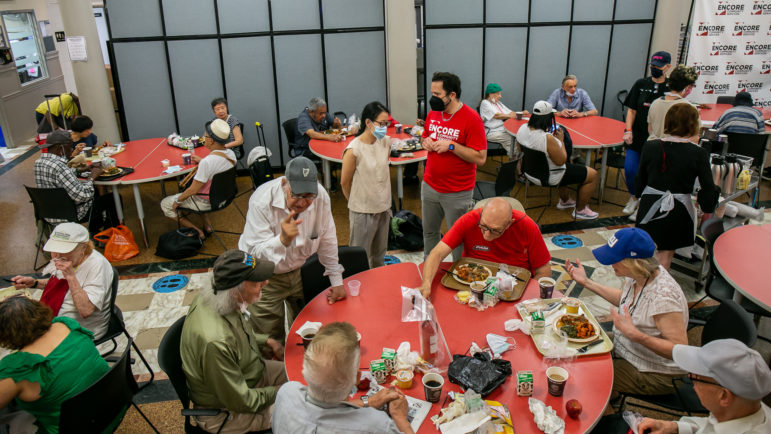It’s already gone further than anyone thought it would.
When the Bloomberg administration started talking about remaking the Greenpoint and Williamsburg waterfront into a blossoming residential district, local community groups pleaded for something in return: new affordable housing for an area in desperate need of it. Specifically, they wanted “inclusionary zoning”–a binding commitment that a substantial portion of the new construction would be within the financial means of the neighborhood’s longtime residents. (Median income for renters: about $27,000.)
No way, said Deputy Mayor Dan Doctoroff and the agencies he oversees. When it released its ambitious redevelopment plans in the summer of 2003, the Department of City Planning remained staunchly opposed to any new measures–even optional incentives–that would ask real estate developers to build affordable housing. Its goal was to maximize the amount of private investment that would flow to build new first-class high-rises and a waterfront esplanade. Period.
What a difference a year, a new city housing commissioner and a well-organized phalanx of community advocates makes. This fall, City Planning and the Department of Housing Preservation and Development announced two new inclusionary zoning efforts-one for the northwest Brooklyn riverfront and one for Manhattan’s Far West Side. Both would reward developers who include a certain number of apartments at reduced prices with the chance to build taller–and therefore more lucrative–buildings. The commitment is a breakthrough, putting New York among the hundreds of cities nationwide that have adopted substantial inclusionary zoning programs.
But it’s not over yet. The zoning changes still have to be approved by the City Council, and Councilmember David Yassky, who represents the Greenpoint-Williamsburg waterfront, is leading the charge to insist that the city, property developers or both commit to producing a significant amount of affordable housing. Community advocates are pushing the issue even further. Their bottom line is that building new affordable housing should not be a choice for developers in Williamsburg, Greenpoint and the new West Side, but a flat-out requirement.
That’s how it usually works. “A lot of cities did it on a voluntary basis as a starting point,” says Douglas R. Porter, author of a recent Urban Land Institute book, sponsored by the Ford Foundation, surveying 15 inclusionary zoning programs nationwide. The track record of such efforts, he concludes, is not impressive. “Until you get to the mandated stage,” says Porter, “it doesn’t work.”
Yassky has a majority of the City Council on his side–all he needs in order to sit down at the bargaining table with housing and planning officials and work out a deal they can all get behind. He has spoken in favor of mandates as one option, yet he has also hinted that he’ll accept an effective incentive program. “I’m very focused on the end product,” says Yassky. “Any way to get there is fine by me.”
Real estate developers hold some high-value cards, too. The entire venture, after all, depends on someone’s willingness to produce and finance the development. Housing construction in New York is already outrageously expensive, and some builders contend that additional obligations could make it difficult for them to obtain financing. They also point out that the real estate market is extremely sensitive to changing market conditions. Will rising interest rates be prohibitive? How about the cost of labor and materials, which are also escalating?
The administration has been listening seriously to developers and their concerns. HPD Commissioner Shaun Donovan warned the state Assembly housing committee, which is considering its own inclusionary zoning legislation, that if there’s even a slight downturn in the real estate market, “our newly rezoned neighborhoods will remain undeveloped and the benefits of the rezoning, including affordable housing, will go unrealized.”
As HPD sees it, demanding that developers build affordable housing is just not worth the risk. “Mandatory inclusionary housing is not the panacea people think it is,” cautions Rafael Cestero, HPD’s deputy commissioner for development. “Mandatory doesn’t get you closer than a voluntary program, because in the end, development is voluntary.”
Should we be worried that inclusionary zoning could kill housing production? In Montgomery County, Maryland, it might have, had county officials not started exempting developers from their obligations. A prosperous D.C. suburban area, Montgomery had the nation’s first inclusionary zoning program, initiated back in 1974. But as space has tightened and development become more expensive, affordable housing production has plummeted. When developers contended they could no longer shoulder the burden, the county began allowing them to inexpensively buy their way out of affordable housing obligations. To fix the problem, county legislators are now revising their zoning code to let builders erect taller, denser real estate, with reinforced obligations to produce or pay for new affordable housing.
Legally, New York City may have no choice but to produce results. Its own draft environmental impact statement for Williamsburg notes that redevelopment will cause substantial displacement of current residents, as they’re priced out of the neighborhood–a consequence it will have to remedy.
HPD is confident that enticements to developers will work. “We believe that our incentives are significant enough that developers will choose to develop affordable housing,” says Cestero. Indeed, HPD’s projections for the number of affordable apartments to be built in Williamsburg assumes that every single developer on the waterfront will elect to use the incentives.
When Shaun Donovan crunches numbers, they’re not to be taken lightly. In his prior work at the U.S. Department of Housing and Urban Development, Donovan was given a somewhat similar task: induce property owners who had built apartments under the federal Section 8 programs to keep their apartments affordable in the long term, instead of hiking them up to market rate. Donovan’s incentives did the job, say affordable housing advocates. “He was instrumental in making the details work,” says Michael Kane of the National Alliance of HUD Tenants. “I found Shaun to be creative, flexible, responsive, highly intelligent. He’s a brilliant policy and numbers person.”
But many New York affordable housing advocates wonder if the Bloomberg administration is putting ideology–specifically an aversion to government intervention in private business–ahead of the public interest. Some independent analysts, notably the Pratt Institute Center for Community and Environmental Development (PICCED), say that the rezoning of an industrial area like the Williamsburg waterfront into a residential one presents a precious opportunity that only mandatory inclusionary zoning can fulfill. The very act of rezoning a manufacturing area into a residential one dramatically increases the value of the land-estimates for Brooklyn range from five- to tenfold. Inclusionary zoning, in these circumstances, is a way for the public sector to capture some of the value that its own rezoning creates.
San Diego launched its first experimental inclusionary zoning program this way, when it opened a new suburban area for development. It now has 800 affordable homes to show for it. “By virtue of the rezoning, the city government is adding value to that real estate,” says Betsy Morris, CEO of the San Diego Housing Commission, the public agency in charge of affordable housing for that city. “I think it’s fair and reasonable that there be some benefit in exchange to the city for doing it.”
Bolstered by PICCED’s research, grassroots groups are pushing for mandates–substantial ones. In mid-November, at a presentation by Planning and HPD to a community board task force, some 700 Williamsburg and Greenpoint residents packed a high school auditorium. A parade of activists with the coalition Mobilization Against Displacement raucously interrupted HPD Deputy Commissioner Rafael Cestero’s presentation of the incentive plan with chants of “We want 40 percent!” That’s the portion of new apartments they want made affordable, for people with much lower incomes than the city is proposing. (The number is derived from a deal local groups made for the redevelopment of the Schaeffer brewery site on the waterfront, where four in 10 apartments will be reserved for lower-income tenants.)
Williamsburg and Greenpoint residents are passionate, informed and organized, and many are not convinced that incentives to real estate developers will address their chief concern: that instead of relieving the neighborhood’s affordable housing shortage, the rebuilding of the waterfront will fuel an upward spiral in the cost of real estate. Williamsburg, they fear, will no longer be a neighborhood they can afford to live in. That concern has been a powerful catalyst for community organizing–organizing that is likely to influence the final plans for the neighborhood.
“Everybody understands that this is a dangerous situation, and when people see resistance to it, it crystallizes an attitude–that they don’t have to accept things they don’t have to accept,” says Marty Needleman, director of Brooklyn Legal Services Corporation and one of the leaders of Mobilization Against Development. “In our community there’s a history of fighting issues until they’re done.”
_______
Want to know more? Check out City Limits’ comprehensive guide to inclusionary zoning. And get a close look at what inclusionary zoning looks like, nationwide: San Diego and San Francisco, CA; Montgomery County, MD; and Boston, MA.
_______
SIDEBAR: Arrested Development
New York isn’t the only big city where advocates and City Council members are going head to head with mayors and builders over whether new residential development has to include affordable housing.
- Washington, D.C.
The nation’s capital currently gives some developers incentives to include affordable housing. Now more than 50 organizations are pushing to make inclusionary zoning a hard and fast requirement; if they get their way, 15 percent of all new housing units would have to be affordable. In January, the City Council is scheduled to vote on a resolution in support of that goal. Mayor Anthony Williams has not indicated where he stands. What Williams wants matters: It will ultimately be up to the District of Columbia’s five-member Zoning Commission, appointed by the mayor and the federal government, to decide whether to amend the zoning code. So far, the commission is proceeding cautiously.
Chicago
After Alderman Toni Preckwinkle proposed a “set-aside” ordinance in 2002, mandating inclusionary zoning citywide, Mayor Richard Daley countered with an array of incentives to get developers to build affordable housing, including density bonuses, parking requirement reductions and land donations. Preckwinkle isn’t giving up on mandates. Her ordinance, which will be the subject of hearings this year, would require 15 percent of all new housing units in Chicago to be affordable. She’s got 24 out of 50 aldermen on board–but without the mayor’s support, the ordinance doesn’t have much of a chance.
Los Angeles
Councilmembers Eric Garcetti and Ed Reyes have proposed an ordinance requiring all new residential buildings with more than five units to include affordable apartments. Mayor James Hahn hasn’t declared where he stands. But it would be hard not to notice strong community opposition, fanned by flyers–distributed by local Realtors–warning that the ordinance would bring outsized development to neighborhoods of single-family homes. Meanwhile, developers have released their own proposals for incentive programs that would reward them for building affordable housing.
–Sarah Unke








